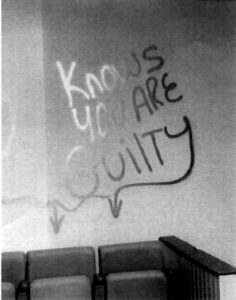
Anybody who’s stepped foot inside a courtroom knows full well the tenor and tone that’s set upon arrival.
You’d think you were attending a Sunday morning church service — but not just any service. More like the Catholic, Episcopalian or Lutheran variety, with lots of liturgy and rituals, hushed tones and above all, best behavior.
Before entering, the bailiff often ensures that behavior is followed — hats off, cell phones away, no outbursts or similar disruption. The judge rules the room, and the utmost respect must be shown to “your honor.”
In nearly every sense, courtrooms constitute hallowed ground in the legal world, sacred halls of justice that demand decorum of the highest order.
And as with the pastor, priest or preacher at the church pulpit, the judge sets the tone inside a courtroom — and in general, leads by example.
So it was with general disbelief when reports surfaced last week that one of our Superior Court judges allegedly desecrated those hallowed halls of justice on his way out the door by spraypainting extensive graffiti in a courtroom, hallways and even the judge’s restroom facility following the move to the county’s new Judicial Campus on South Main Street in Martinsville.
Based on the photos we obtained (which don’t capture the full extent, from all I understand), he used black and gold spray cans for the job. His handiwork included Bigfoot, Lady Justice, the scales of justice, at least one expletive — “FAT ***holE!” (he later said he was referring to himself amid self-deprecation) — and a whole host of other messaging, including commentary on jurors, and based on multiple independent reports, a former judicial colleague.
According to the judge and the arrows he painted to the seats in the jury box, the “alternative juror (has no idea)” while the rest of the jury “knows you are guilty.”
To be fair, the historic courthouse is getting completely renovated, and as part of the renovation, much of the interior is getting gutted and demolished. So the judge’s “artwork” will be in a dumpster soon enough, if it’s not already.
But the behavior still doesn’t sit well.
The Morgan County Courthouse — and the courtrooms it holds — has been the literal and figurative center of justice in this county since 1859. Serious cases of lasting impact have unfolded within those walls. Lives have been permanently altered by decisions made in that building. The very foundations of our community have been shaken by verdicts that have been passed down, by the identities of those convicted, by the innocence of those victimized — all within that building.
Nevermind the irony of the occurrence, but to think a sitting judge would vandalize these venerated walls with markings typically reserved for juveniles (who might very well end up in court for those actions), well, I can only shake my head in general dismay.
And in keeping with the analogy, I can’t help but liken it to a pastor spraypainting the church pulpit or the walls of a church sanctuary that’s slated for renovations.
At the basic level, it’s sophomoric, irreverent and crude. But there are plenty more levels and layers at work here.
Lest I remind you, a judge is legally bound by the “Indiana Code of Judicial Conduct,” and the preamble of that code lays out the intent.
Point [2] of the preamble underscores a particular point: “Judges should maintain the dignity of judicial office at all times … . They should aspire at all times to conduct that ensures the greatest possible public confidence in their independence, impartiality, integrity, and competence.”
It later adds in Point [3] that the Code is intended “to provide guidance and assist judges in maintaining the highest standards of judicial and personal conduct, and to provide a basis for regulating their conduct through disciplinary agencies.”
In the “Scope” of the Code, it further emphasizes that “judges should strive to exceed the standards of conduct established by the Rules, holding themselves to the highest ethical standards and seeking to achieve those aspirational goals, thereby enhancing the dignity of the judicial office.”
I spoke with Judge Williams by phone on Tuesday, and he wasn’t sure what the hullabaloo was all about, characterizing his graffiti as “silliness on the way out the door.”
He explained that he received permission to spraypaint the interior of the courthouse from county administrator Josh Messmer just before the official move to the new Judicial Campus. And Williams knew the courthouse was “going to be torn up mere days later.”
Messmer acknowledged giving permission but didn’t know that would translate to the extent of graffiti and messaging it did.
Williams said he didn’t either, saying his artistic inspiration was “all in the moment.”
“If anyone’s upset, I’ll own it,” Williams said on Tuesday’s call.
Suffice it to say, plenty of people are upset, but what that “ownership” entails remains to be seen.
I wouldn’t think Williams’ actions would constitute criminality, but I’ll leave that to the legal minds. And I suspect those same minds may have other thoughts on the subject, starting with the code of judicial conduct.
Editor Stephen Crane is a husband, father of four and Morgan County native. Contact him at 765-201-0010 or at scrane@morgancountycorrespondent.com.








